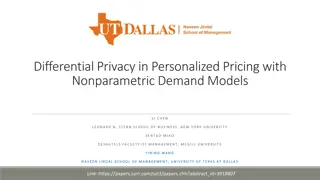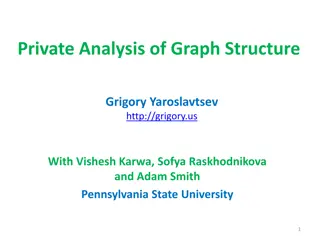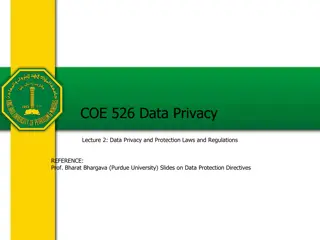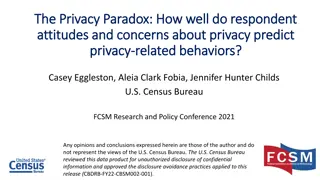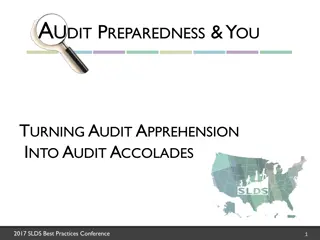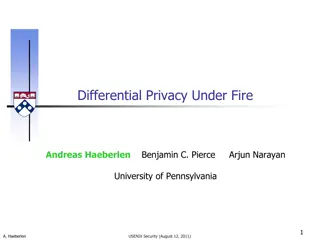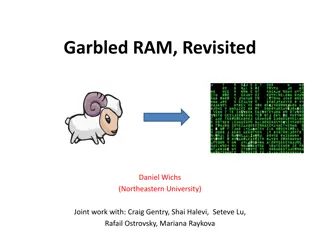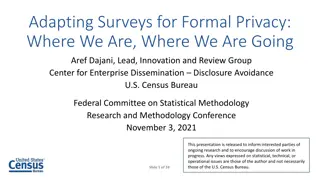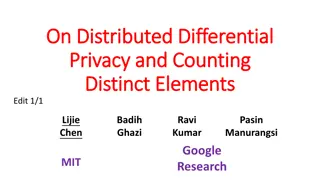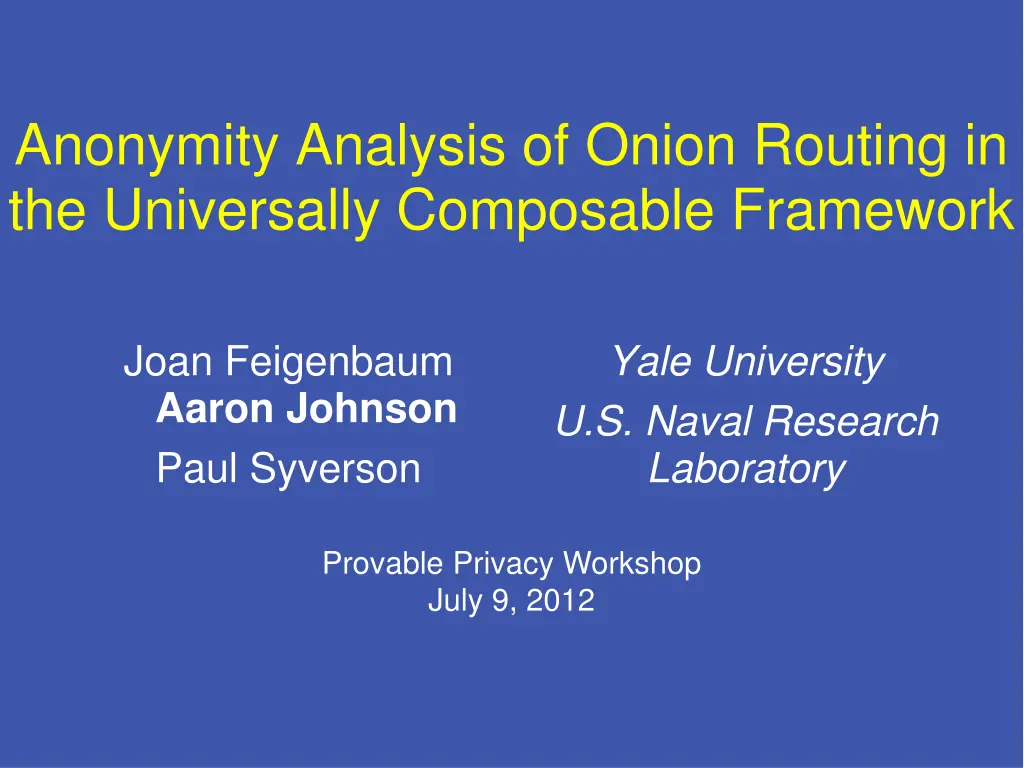
Anonymity Analysis of Onion Routing in Universally Composable Framework
Explore the formalization and analysis of onion routing in the Universally Composable framework to provide enhanced anonymity. The study focuses on the implications of information leaks and adversary control in the onion routing process, offering solutions for improved privacy and security.
Download Presentation

Please find below an Image/Link to download the presentation.
The content on the website is provided AS IS for your information and personal use only. It may not be sold, licensed, or shared on other websites without obtaining consent from the author. If you encounter any issues during the download, it is possible that the publisher has removed the file from their server.
You are allowed to download the files provided on this website for personal or commercial use, subject to the condition that they are used lawfully. All files are the property of their respective owners.
The content on the website is provided AS IS for your information and personal use only. It may not be sold, licensed, or shared on other websites without obtaining consent from the author.
E N D
Presentation Transcript
Anonymity Analysis of Onion Routing in the Universally Composable Framework Joan Feigenbaum Aaron Johnson Paul Syverson Yale University U.S. Naval Research Laboratory Provable Privacy Workshop July 9, 2012
Problem [FJS07a] - Onion-routing I/O-automata model - Possibilistic anonymity analysis [FJS07b] - Onion-routing abstract model - Probabilistic anonymity analysis [ ] - How do we apply results in standard cryptographic models? [CL05] - Onion routing formalized with Universal Composability (UC) - No anonymity analysis [BGKM12] - Onion routing formalized with UC - Our work will provide anonymity
Solution Formalize abstract (black-box) model of onion routing in UC framework Focus on information leaked Anonymity analysis on earlier abstract model is inherited by UC version
Problem [FJS07a] - Onion-routing I/O-automata model - Possibilistic anonymity analysis [FJS07b] - Onion-routing abstract model - Probabilistic anonymity analysis [ ] - How do we apply results in standard cryptographic models? [CL05] - Onion routing formalized with Universal Composability (UC) - No anonymity analysis [BGKM12] - Onion routing formalized with UC - Our work will provide anonymity
I/O-automata model Adversary controls relays 1 2 u d 3 5 User u running client Internet destination d 4 Onion routing relays Encrypted onion-routing hop Unencrypted onion-routing hop
I/O-automata model 1 2 u d 3 5 4 u 1 2 Main theorem: Adversary can only determine parts of a circuit it controls or is next to.
I/O-automata model u 1 2 d v e 3 5 4 w f 1. 2. 3. 4.
I/O-automata model u 1 2 d v e 3 5 4 w f 1. First router compromised 2. 3. 4.
I/O-automata model u 1 2 d v e 3 5 4 w f 1. First router compromised 2. Last router compromised 3. 4.
I/O-automata model u 1 2 d v e 3 5 4 w f 1. First router compromised 2. Last router compromised 3. First and last compromised 4.
I/O-automata model u 1 2 d v e 3 5 4 w f 1. First router compromised 2. Last router compromised 3. First and last compromised 4. Neither first nor last compromised
Problem [FJS07a] - Onion-routing I/O-automata model - Possibilistic anonymity analysis [FJS07b] - Onion-routing abstract model - Probabilistic anonymity analysis [ ] - How do we apply results in standard cryptographic models? [CL05] - Onion routing formalized with Universal Composability (UC) - No anonymity analysis [BGKM12] - Onion routing formalized with UC - Our work will provide anonymity
Black-box Abstraction u d v e w f
Black-box Abstraction u d v e w f 1. Users choose a destination
Black-box Abstraction u d v e w f 1. Users choose a destination 2. Some inputs are observed
Black-box Abstraction u d v e w f 1. Users choose a destination 2. Some inputs are observed 3. Some outputs are observed
Black-box Anonymity u d v e w f The adversary can link observed inputs and outputs of the same user.
Black-box Anonymity u d v e w f The adversary can link observed inputs and outputs of the same user. Any configuration consistent with these observations is indistinguishable to the adversary.
Black-box Anonymity u d v e w f The adversary can link observed inputs and outputs of the same user. Any configuration consistent with these observations is indistinguishable to the adversary.
Black-box Anonymity u d v e w f The adversary can link observed inputs and outputs of the same user. Any configuration consistent with these observations is indistinguishable to the adversary.
Probabilistic Black-box u d v e w f
Probabilistic Black-box u d v e w f pu Each user v selects a destination from distribution pv
Probabilistic Black-box u d v e w f pu Each user v selects a destination from distribution pv Inputs and outputs are observed independently with probability b
Problem [FJS07a] - Onion-routing I/O-automata model - Possibilistic anonymity analysis [FJS07b] - Onion-routing abstract model - Probabilistic anonymity analysis [ ] - How do we apply results in standard cryptographic models? [CL05] - Onion routing formalized with Universal Composability (UC) - No anonymity analysis [BGKM12] - Onion routing formalized with UC - Our work will provide anonymity
Problem [FJS07a] - Onion-routing I/O-automata model - Possibilistic anonymity analysis [FJS07b] - Onion-routing abstract model - Probabilistic anonymity analysis [FJS12] Onion-routing UC formalization - Free probabilistic anonymity analysis [CL05] - Onion routing formalized with Universal Composability (UC) - No anonymity analysis [BGKM12] - Onion routing formalized with UC - Our work will provide anonymity
Onion-Routing UC Ideal Functionality Upon receiving destination d from user U u with probability b with probability 1-b x d with probability b with probability 1-b y Send (x,y) to the adversary. FOR
Black-box Model Ideal functionality FOR Environment assumptions Each user gets a destination Destination for user u chosen from distribution pu Adversary compromises a fraction b of routers before execution
UC Formalization Captures necessary properties of any crytographic implementation Easy to analyze resulting information leaks Functionality is a composable primitive Anonymity results are valid in probabilistic version of I/O-automata model
Anonymity Analysis of Black Box Can lower bound expected anonymity with standard approximation: b2 + (1-b2)pud Worst case for anonymity is when user acts exactly unlike or exactly like others Worst-case anonymity is typically as if b routers compromised: b + (1-b)pud Anonymity in typical situations approaches lower bound
Future Extensions Compromised links Non-uniform path selection Heterogeneous path selection Anonymity over time
Problem [FJS07a] - Onion-routing I/O-automata model - Possibilistic anonymity analysis [FJS07b] - Onion-routing abstract model - Probabilistic anonymity analysis [FJS12] Onion-routing UC formalization - Free probabilistic anonymity analysis [CL05] - Onion routing formalized with Universal Composability (UC) - No anonymity analysis [BGKM12] - Onion routing formalized with UC - Our work will provide anonymity
[BGKM12] Ideal Functionality Functionality can actually send messages Needs wrapper to hide irrelevant circuit-building options Shown to UC-emulate FOR
References [BGKM12] Provably Secure and Practical Onion Routing, by Michael Backes, Ian Goldberg, Aniket Kate, and Esfandiar Mohammadi, in CSF12. [CL05] A Formal Treatment of Onion Routing, by Jan Camenisch and Anna Lysyanskaya, in CRYPTO 05. [FJS07a] A Model of Onion Routing with Provable Anonymity,by Joan Feigenbaum, Aaron Johnson, and Paul Syverson, in FC07. [FJS07b] Probabilistic Analysis of Onion Routing in a Black-box Model, id., in WPES07. [FJS12] A Probabilistic Analysis of Onion Routing in a Black-box Model, id. in TISSEC (forthcoming)

